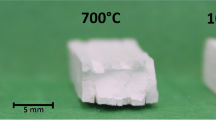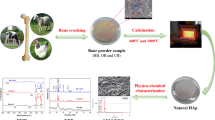Abstract
Bioapatite ceramics produced from biogenic sources provide highly attractive materials for the preparation of artificial replacements since such materials are not only more easily accepted by living organisms, but bioapatite isolated from biowaste such as xenogeneous bones also provides a low-cost material. Nevertheless, the presence of organic compounds in the bioapatite may lead to a deterioration in its quality and may trigger an undesirable immune response. Therefore, procedures which ensure the elimination of organic compounds through bioapatite isolation are being subjected to intense investigation and the presence of remaining organic impurities is being determined through the application of various methods. Since current conclusions concerning the conditions suitable for the elimination of organic compounds remain ambiguous, we used the mass spectrometry-based proteomic approach in order to determine the presence of proteins or peptides in bioapatite samples treated under the most frequently employed conditions, i.e., the alkaline hydrothermal process and calcination at 500 °C. Since we also investigated the presence of proteins or peptides in treated bioapatite particles of differing sizes, we discovered that both calcination and the size of the bioapatite particles constitute the main factors influencing the presence of proteins or peptides in bioapatite. In fact, while intact proteins were detected even in calcinated bioapatite consisting of particles >250 µm, no proteins were detected in the same material consisting of particles <40 µm. Therefore, we recommend the use of powdered bioapatite for the preparation of artificial replacements since it is more effectively purified than apatite in the form of blocks. In addition, we observed that while alkaline hydrothermal treatment leads to the non-specific cleavage of proteins, it does not ensure the full degradation thereof.



Similar content being viewed by others
References
Ben-Nissan B. Natural bioceramics: from coral to bone and beyond. Curr Opin Solid State Mater Sci. 2003;7:283–8.
Šupová M. Isolation and preparation of nanoscale bioapatites from natural sources: a review. J Nanosci Nanotechnol. 2014;14:1–18.
LeGeros RZ. Biological and synthetic apatites. In: Brown PW, Constantz B, editors. Hydroxyapatite and Related Materials. Boca Raton: CRC Press; 1994.
Termine JD, Eanes ED, Greenfield DJ, Nylen MU. Hydrazine-deproteinated bone mineral. Physical and chemical properties. Calc Tiss Res. 1973;12:73–90.
Sobczak-Kupiec A, Wzorek Z. The influence of calcination parameters on free calcium oxide content in natural hydroxyapatite. Ceram Int. 2012;38:641–7.
Raspanti M, Guizzardi S, De Pasquale V, Martini D, Ruggeri A. Ultrastructure of heat-deproteinated compact bone. Biomaterials. 1994;15:433–7.
Guizzardi S, Montanari C, Migliaccio S, Strocchi R, Solmi R, Martini D, et al. Qualitative assessment of natural apatite in vitro and in vivo. J Biomed Mater Res B. 2000;53:227–34.
Barakat NAM, Khalil KA, Sheikh FA, Omran AM, Gaihre B, Khil SM, et al. Physiochemical characterizations of hydroxyapatite extracted from bovine bones by three different methods: extraction of biologically desirable Hap. Mater Sci Eng C. 2008;28:1381–7.
Barakat NAM, Khil SM, Omran AM, Sheikh FA, Kim HY. Extraction of pure natural hydroxyapatite from the bovine bones bio waste by three different methods. J Mater Process Technol. 2009;209:3408–15.
Sobczak A, Kida A, Kowalski Z, Wzorek Z. Evaluation of the biomedical properties of hydroxyapatite obtained from bone waste, Pol. J. Chem. Technol. 2009;11:37–43.
Murugan R, Panduranga Rao K, Sampath Kumar TS. Heat-deproteinated xenogeneic bone from slaughterhouse waste: Physico-chemical properties. Bull Mater Sci. 2003;26:523–8.
Haberko K, Bućko MM, Brzezińska-Miecznik J, Haberko M, Mozgawa W, Panz T, et al. Natural hydroxyapatite—its behaviour during heat treatment. J Eur Ceram Soc. 2006;26:537–42.
Lombardi M, Palmero P, Haberko K, Pyda W, Montanaro L. Processing of a natural hydroxyapatite powder: From powder optimization to porous bodies development. J Eur Ceram Soc. 2011;31:2513–8.
Pallela R, Venkatesan J, Kim SK. Polymer assisted isolation of hydroxyapatite from Thunnus obesus bone. Ceram Int. 2011;37:3489–97.
Venkatesan J, Kim SK. Effect of temperature on isolation and characterization of hydroxyapatite from Tuna (Thunnus obesus) bone. Materials. 2010;3:4761–72.
Huang YC, Hsiao PC, Chai HJ. Hydroxyapatite extracted from fish scale: Effects on MG63 osteoblast-like cells. Ceram Int. 2011;37:1825–31.
Yoganand CP, Selvarajan V, Goudouri OM, Paraskevopoulos KM, Wu J, Xue D. Preparation of bovine hydroxyapatite by transferred arc plasma. Curr Appl Phys. 2011;11:702–9.
Boutinguiza M, Pou J, Comesaña R, Lusquiños F, De Carlos A, León. Biological hydroxyapatite obtained from fish bones. Mat Sci Eng C. 2012;32:478–86.
Ooi CY, Hamdi M, Ramesh S. Properties of hydroxyapatite produced by annealing of bovine bone. Ceram Int. 2007;33:1171–7.
Emadi R, Roohani Esfahani SI, Tavangarian F. A novel, low temperature method for homthe preparation of ß-TCP/HAP biphasic nanostructured ceramic scaffold from natural cancellous bone. Mater Lett. 2010;64:993–6.
Ozawa M, Suzuki S. Microstructural development of natural hydroxyapatite originated from fish-bone waste through heat treatment. J Am Ceram Soc. 2002;85:1315–7.
Shi XD, Chen LW, Li SW, Sun XD, Cui FZ, Ma HM. The observed difference of RAW264.7 macrophage phenotype on mineralized collagen and hydroxyapatite. Biomed Mater. 2018;13:041001.
Lowry OH, Rosebrough NJ, Farr AL, Randall RJ. Protein measurement with the folin phenol reagent. J Biol Chem. 1951;193:265–75.
Etok SE, Valsami-Jones E, Wess TJ, Hiller JC, Maxwell CA, Rogers KD, et al. Structural and chemical changes of thermally treated bone apatite. J Mater Sci. 2007;42:9807–16.
Hynek R, Kuckova S, Hradilova J, Kodicek M. Matrix-assisted laser desorption/ionization time-of-flight mass spectrometry as a tool for fast identification of protein binders in color layers of paintings. Rapid Commun Mass Sp. 2004;18:1896–900.
Kuckova S, Hynek R, Kodicek M. Application of peptide mass mapping on proteins in historical mortars. J Cult Herit. 2009;10:244–7.
Zeman A, Šmíd M, Havelcová M, Coufalová L, Kučková Š, Velčovská M, et al. The structure and material composition of ossified aortic valves identified using a set of scientific methods. J Asian Earth Sci. 2013;77:311–7.
Buckley M, Collins M, Thomas-Oates J. A method of isolating the collagen (I) α2 chain carboxytelopeptide for species identification in bone fragments. Analyt Biochem. 2008;374:325–34.
Buckley M, Collins M, Thomas-Oates J, Wilson JC. Species identification by analysis of bone collagen using matrix-assisted laser desorption/ionisation time-of-flight mass spectrometry. Rapid Commun Mass Spectrom. 2009;23:3843–54.
Murugan R, Ramakrishna S, Panduranga Rao K. Nanoporous hydroxy-carbonate apatite scaffold made of natural bone. Mater Lett. 2006;60:2844–7.
Haberko K, Bućko MM, Mozgawa W, Pyda A, Brzezińska-Miecznik J, Carpentier J. Behaviour of bone origin hydroxyapatite at elevated temperatures and in O2 and CO2 atmospheres. Ceram Int. 2009;35:2537–40.
Nielsen-Marsh CM, Stegemann C, Hoffmann R, Smith T, Feeney R, Toussaint M, et al. Extraction and sequencing of human and neanderthal mature enamel proteins using MALDI-TOF/TOF MS. J Arch Sci. 2009;36:1758–63.
Silva JC, Gorenstein MV, Li GZ, Vissers JP, Geromanos SJ. Absolute quantification of proteins by LCMSE: a virtue of parallel MS acquisition. Mol Cell Proteomics. 2006;5:144–56.
Grossmann J, Roschitzki B, Panse C, Fortes C, Barkow-Oesterreicher S, Rutishauser D, et al. Implementation and evaluation of relative and absolute quantification in shotgun proteomics with label-free methods. J Proteomics. 2010;5:1740–6.
Ludwig C, Claassen M, Schmidt A, Aebersold R. Estimation of absolute protein quantities of unlabeled samples by selected reaction monitoring mass spectrometry. Mol Cell Proteomics. 2012;11:M111.013987.
Ishihama Y, Oda Y, Tabata T, Sato T, Nagasu T, Rappsilber J, et al. Exponentially modified protein abundance index (emPAI) for estimation of absolute protein amount in proteomics by the number of sequenced peptides per protein. Mol Cell Proteomics. 2005;4:1265–72.
Vogel C, Marcotte EM. Calculating absolute and relative protein abundance from mass spectrometry-based protein expression data. Nat Protoc. 2008;3:1444–51.
Malmström J, Beck M, Schmidt A, Lange V, Deutsch EW, Aebersold R. Proteome-wide cellular protein concentrations of the human pathogen Leptospira interrogans. Nature. 2009;460:762–5.
Schwanhäusser B, Busse D, Li N, Dittmar G, Schuchhardt J, Wolf J, et al. Global quantification of mammalian gene expression control. Nature. 2011;473:337–42.
Kronick PL, Cooke P. Thermal stabilization of collagen fibers by calcification. Connect Tissue Res. 1996;33:275–82.
Bonar LC, Glimcher MJ. Thermal denaturation of mineralized and demineralized bone collagen. J Ultrastr Res. 1970;32:545–51.
Nielsen-Marsh CM, Hedges REM, Mann T, Collins MJ. A preliminary investigation of the application of differential scanning calorimetry to the study of collagen degradation in archaeological bone. Thermochim Acta. 2000;365:129–39.
Bigi A, Cojazzi G, Panzavolta S, Ripamonti A, Roveri N, Romanello M, et al. Chemical and structural characterization of the mineral phase from cortical and trabecular bone. J Inorg Biochem. 1997;68:45–51.
Tadic D, Epple M. A thorough physicochemical characterisation of 14 calciumphosphate-based bone substitution materials in comparison tonatural bone. Biomaterials. 2004;25:987–94.
Šupová M, Suchý T, Sucharda Z, Filová E, der Kinderen JNLM, Steinerová M. et al. The comprehensive in vitro evaluation of eight different calcium phosphates: significant parameters for cell behavior. J Amer Ceram Soc. 2019;102:2882–904.
Pasteris JD, Wopenka B, Freeman JJ, Rogers K, Valsami-Jones E, van der Houwen JAM, et al. Lack of OH in nanocrystalline apatite as a function of degree of atomic order: implications for bone and biomaterials. Biomaterials. 2004;25:229–38.
Shih WJ, Wang JW, Wang MC, Hon MH. A study on the phase transformation of the nanosized hydroxyapatite synthesized by hydrolysis using in situ high temperature X-ray diffraction. Mater Sci Eng C. 2006;26:1434–8.
Acknowledgements
We are grateful for the financial support provided for our work via a Ministry of Health of the Czech Republic grant project (NV15-25813A) and a Specific University research grant (MSMT No 20/2018), Czech Republic. We cordially thank Dr. Jiří Šantrůček and Ing. Lucie Maršálová at the Laboratory of Applied Proteomics of the University of Chemistry and Technology in Prague for providing the LC-ESI-Q-TOF MS data. Finally, special thanks go to Mr. Darren Ireland for the English language correction of the paper.
Author information
Authors and Affiliations
Corresponding author
Ethics declarations
Conflict of interest
The authors declare that they have no conflict of interest.
Additional information
Publisher’s note Springer Nature remains neutral with regard to jurisdictional claims in published maps and institutional affiliations.
Supplementary information
Rights and permissions
About this article
Cite this article
Smrhova, T., Junkova, P., Kuckova, S. et al. Peptide mass mapping in bioapatites isolated from animal bones. J Mater Sci: Mater Med 31, 32 (2020). https://doi.org/10.1007/s10856-020-06371-z
Received:
Accepted:
Published:
DOI: https://doi.org/10.1007/s10856-020-06371-z




